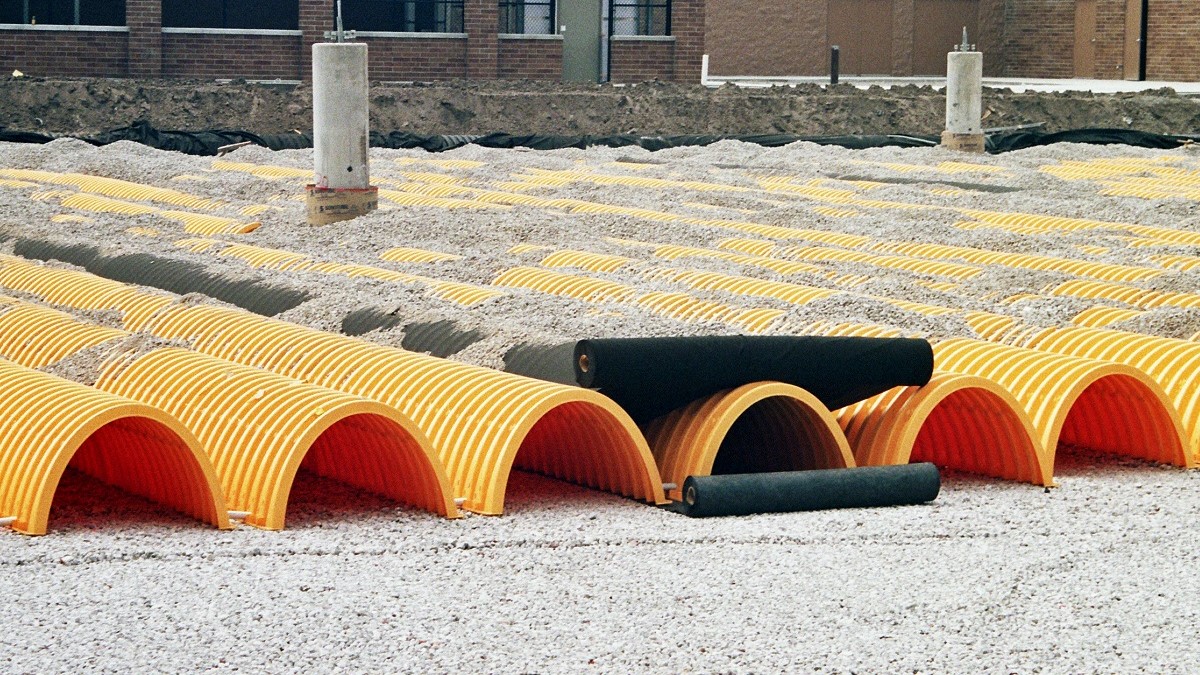
There’s a choice of underground SuDS attenuation systems for new developments, each with their pros and cons. In the first article in a series of two, Stuart Crisp, UK manager of Advanced Drainage Systems, looks at large diameter pipes and crates together with the codes and standards that should be referenced in a product specification.
Large diameter pipes can be used for attenuation as a pipe laid in a single run or more commonly as a manifolded system, with pipes running in parallel lines. The most commonly used materials are concrete and plastic, although there are thin steel pipes and a hybrid product combining plastic and steel on the market.
Large diameter pipes can be a cost-effective choice of attenuation system, as long as there is sufficient available area to accommodate the volume of water that has to be stored. Where the attenuation space is beneath a public road, pipes that meet the required structural performance and highways authority requirements, can sometimes be used.
The choice of material will depend on considerations including capital cost, whole life cost taking into account maintenance and how many times a system may need replacing or upgrading and logistics requirements such as construction plant lifting capacity required and space for installation.
Pipes should be designed to BS 9295 to ensure their structural performance. Note that when pipes are laid in parallel, as is often the case for below-ground SuDS attenuation applications, a different approach to structural design is usually required compared with pipes laid as a single run.
For concrete pipes, BS EN 1916 and BS 5911-1 provide the details for product specifications. For plastic pipes, BS EN 13476 provides the details for product specifications.
| Table of Standards relevant to large diameter pipes | |
| BS 9295:2020 | Guide to the structural design of buried pipes |
| Table of Standards Relevant to Concrete large diameter pipes | |
| BS EN 1916: 2002 | Concrete pipes and fittings, unreinforced, steel fibre and reinforced |
| BS5911-1 | Concrete pipes and ancillary concrete products (recently updated to align with Eurocodes) |
| Table of Standards relevant to plastic pipes
|
|
| EN 13476 | Plastics piping systems for non-pressure underground drainage and sewerage – Structured-wall piping systems of unplasticised polyvinyl chloride (PVC-U), polypropylene (PP) and polyethylene (PE) |
Crates
Crates or geocellular units can be a desirable choice of attenuation system where there is limited plan area since they provide a large void space for a limited footprint. There are a variety of geocellular unit types on the market which can be used at varying depths from shallow sub-base replacement systems for car parks to deeper attenuation tanks for higher volumes of storage.
Geocellular units are typically manufactured from polypropylene (PP) or PVC by injection molding, extrusion of joining thermoformed sheets. Assessment of the performance of thermoplastics (including plastic pipes and arches) needs to take into account the influence of creep over time; creep is the tendency to deform permanently over time under a constant stress.
Structural assessments of crates must consider short-term loading such as traffic and long-term loading, such as the weight of material above the tank and lateral earth loads. Use BS EN 17150, 17151 and 17152-1, along with material tests, to determine characteristic long-term and short-term strengths and specifications.
A geotextile or geomembrane is also part of the geocellular attenuation system and therefore must be properly specified, selected and installed. Catchpits, separators and other pre-treatment measures are vital to prevent the build-up of silt and sediment within the geocellular structure. CIRIA C737 explains how the long-term volume capacity of a crate should take into account the impact of silt and sediment. The need for effective sediment management as part of a crate-based below-ground SuDS attenuation system is also emphasized in CIRIA C753 The SuDS Manual.
| Table of Standards relevant to crates | |
| CIRIA C737 | Structural and geotechnical design of modular geocellular drainage systems |
| BS EN17152-1 | Plastics piping systems for non-pressure underground conveyance and storage of non-potable water – Boxes used for infiltration, attenuation and storage systems Part 1: Specifications for storm water boxes made of PP and PVC-U |
This article has been provided by Stuart Crisp at Advanced Drainage Systems – visit adspipe.co.uk



